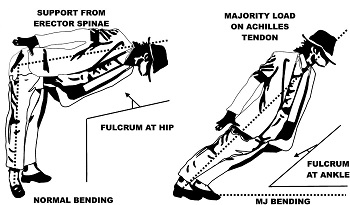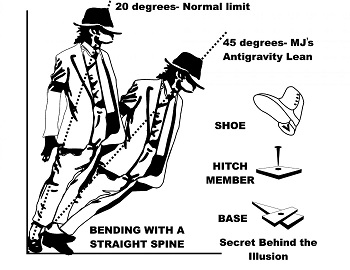Biomechanics experts warn against trying the ‘anti-gravity’ tilt at home.
In this article neurosurgeons explore the techniques used by Michael Jackson to achieve the famous ‘Smooth Criminal’ dance lean. Furthering our knowledge of how STEM concepts are used to enhance understanding, the experts explain the physics behind this gravity defying dance move. The content can be used alongside the Year 7 (ACSSU117) or Year 10 (ACSSU229) Physical Science curriculum (Forces and Motion). The associated Teacher Resource includes a set of STEM Discovery Questions, use them to conduct class or small group discussions or to create an individual review and reflection task.
USE BUTTONS TO EXPLORE AVAILABLE RESOURCES
EXPLORE ARTICLE RESOURCE
Smooth moves from a Smooth Criminal – Explaining Michael Jackson’s dance lean
You’d be hard-pressed to find anyone who doesn’t agree that Michael Jackson was one of the most influential musical artists of our time. But it wasn’t only music he influenced and revolutionised. His dance moves defined pop music choreography, and pushed dancers to do more and more extreme moves.
Now one of his signature moves – the extreme lean from Smooth Criminal – has come under the microscope, with a group of Indian neurosurgeons and self-confessed Jackson fans, discussing how he pulled off the move in the Journal of Neurosurgery Spine, and cautioning against those wanting to replicate their idol.
Mind-boggling lean

In the video for Smooth Criminal, and then replicated live in concerts around the world, Jackson and his backup dancers perform a mind-boggling lean, which sees their bodies tilted forwards from the ankle at an angle of 45 degrees from vertical.
When someone stands upright, their centre of mass lies in front of the second sacral vertebra.
If we were to bend forward at the waist, our erector spinae muscles in the back act like cables to support the spinal column and prevent us from toppling as that centre of gravity moves forwards.
Even a trained dancer, say the neurosurgeons, would only be able to lean around 20 degrees past vertical without toppling, far more upright than MJ’s 45 degrees.
No strings attached
So what was Jackson’s secret? Well, apparently it wasn’t wires, but rather a mechanical widget in the form of a patented shoe.
The heel of the shoe contained a slot that locked onto a metallic peg that emerged from the stage at the right moment, locking his foot in place and providing an anchor to allow the extreme angles. However, they say, even with this hitching system it would still require huge core strength to be able to lock his body into a rigid straight line while leaning over and pulling himself back upright.
The University of Adelaide’s Associate Professor Dominic Thewlis, who was not involved in the paper but specialises in human biomechanics, agrees, but also points out it wasn’t something that only Jackson would be able to do.
“Based on some very simple calculations from the information in the paper, the muscle force required to hold this position is massive.”
“It’s genuinely surprising, we’re talking about huge forces on his ankles.”
“Once Michael’s centre of mass exceeds the limits of the base of support (his foot) the system is really easily perturbed, so the only way to hold this position without losing balance would be to fix his ankle to the floor. The rest is down to core strength.”
While the move would have required strength far beyond what a normal person could muster, Thewlis says that it was probably far from superhuman and that most trained dancers should have this kind of ability. However, even with this strength, Thewlis points to the shoe design as being the vital ingredient in the show stopping move.
“I honestly can’t see how anyone could do this without mechanical aid.”
Do not try this at home
It is those forces and the requirement for the special shoe that has the Indian doctors cautioning against trying to replicate Jackson’s moves at home.
“Several MJ fans, including the authors, have tried to copy this move and failed, often injuring themselves in their endeavours,” they wrote.
The chances of someone injuring their ankles while trying to make the lean are significant, they said. Talking to the BBC, the authors added “You need strong core muscles and good support around the ankle. It’s not a simple trick.”
Since Jackson’s prime, dancers have continually challenged themselves to jump higher, stretch further and move faster than before.
With this comes more strain on their bodies, and the neurosurgeons say they are expecting to see new, unique spinal injuries as dancers push themselves further, inspired by the phenomenon that was Michael Jackson.
Physical Sciences – Forces & Motion – Related Content:
EXPLORE TEACHER RESOURCE
Login or Sign up for FREE to download the full teacher resource
The teacher resource includes a student resource idea focusing on ‘Sharing Understanding’ and ‘Communicating & Collaborating’. Students can demonstrate their understanding of the article content and related STEM knowledge via a set of STEM DISCOVERY QUESTIONS. Focused on the development of content understanding and inquiry skills, use the questions to conduct class or small group discussions, or as the basis for an individual review and reflection task.







